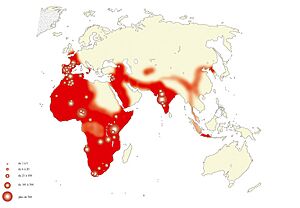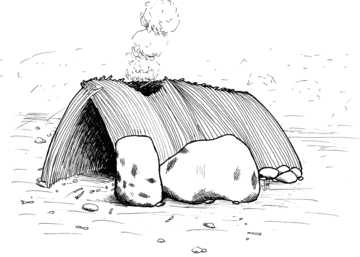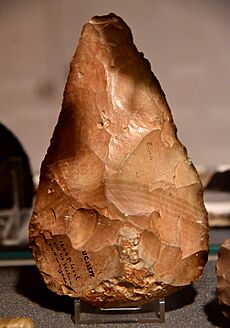Acheulean facts for kids

Map of the distribution of Middle Pleistocene (Acheulean) cleaver finds
|
|
| Geographical range | Africa, Europe, and Asia |
|---|---|
| Period | Lower Paleolithic |
| Dates | 1.95–0.13 Mya |
| Type site | Saint-Acheul (Amiens) |
| Preceded by | Oldowan |
| Followed by | Mousterian, Clactonian, Micoquien, Aterian, Soanian, Sangoan, Acheulo-Yabrudian complex, Fauresmith industry |

The Acheulean (say: ah-SHOO-lee-uhn) is a type of stone tool making from long ago. It's named after Saint-Acheul in France, where these tools were first found. This tool-making style is known for its special oval and pear-shaped "hand axes." These tools were made by early humans like Homo erectus and Homo heidelbergensis.
Acheulean tools were used during the Lower Palaeolithic era. This was a very early part of the Stone Age. You can find these tools across Africa, Asia, and Europe. They are often found near the remains of Homo erectus. Scientists believe Acheulean tools first appeared about 2 million years ago. They likely developed from an older, simpler tool style called Oldowan technology.
The Acheulean period lasted a very long time. It ended around 130,000 years ago in some places. In Europe, early Neanderthals used Acheulean tools. Later, they switched to a different tool style called Mousterian.
Contents
Discovering Acheulean Tools
How We Learned About These Ancient Tools
The main place where Acheulean tools were first identified is Saint-Acheul. This is a suburb of Amiens in France. Tools were found there in 1859.
A person named John Frere was one of the first to guess how old these tools were. In 1797, he sent two hand axes to the Royal Academy in London. He found them in old lake beds with bones of animals that are now extinct. He thought they were made by people who didn't use metal. He believed they were from "a very ancient period indeed." But people at the time didn't believe him.
Later, Jacques Boucher de Crèvecœur de Perthes collected more hand axes. He found them in river gravels near Abbeville, France. He also thought they were very old. His ideas were also not accepted at first. But then, other scientists, like Marcel Jérôme Rigollot, started finding more tools. Finally, a geologist named Joseph Prestwich visited the sites. After his visits, the great age of these tools was accepted.
In 1872, Louis Laurent Gabriel de Mortillet named these hand-axe tools L'Epoque de St Acheul. The name was changed to Acheulean in 1925.
How Old Are Acheulean Tools?
Dating Ancient Stone Tools
Scientists use special methods to figure out how old stone tools are. These methods include radiometric dating and magnetostratigraphy.
- In Ethiopia, Acheulean hand axes have been dated to about 1.5 million years ago. This was done by dating volcanic ash layers nearby.
- Tools found in South Asia are also about 1.5 million years old.
- More recent discoveries in Kenya show tools from about 1.76 million years ago.
- Even older tools from Ethiopia were reported in 2023, dating to 1.95 million years ago.
The earliest users of Acheulean tools might have been Homo ergaster. This early human appeared about 1.8 million years ago. However, other early human species, like Homo habilis, also lived in East Africa then. So, we can't be sure who made the very first Acheulean tools.
Where Acheulean Tools Spread
It seems the Acheulean tool-making style started in Africa. Then it spread to Asia, the Middle East, and Europe. This happened between 1.5 million and 800,000 years ago. For a long time, people thought these tools didn't reach Europe until about 500,000 years ago. But newer research shows hand axes from Spain are over 900,000 years old.
Acheulean tools were more advanced than earlier tools. But there was a time when different tool styles were used at the same time. For example, Acheulean tools were used alongside simpler Clactonian tools. Later, they were used with more complex Mousterian tools. So, the Acheulean wasn't a neat, separate time period. It was a successful tool-making method that spread widely.
The Acheulean style doesn't mean people shared the same "culture" everywhere. Instead, it was a basic way of making stone tools. This method was used across much of the ancient world. The very first Acheulean tools often look like older Oldowan tools. This suggests the Acheulean style grew out of the Oldowan.
The Acheulean period ended at different times in different places.
- In Africa and the Near East, it ended around 175,000 to 166,000 years ago.
- In Europe, it ended around 141,000 to 130,000 years ago.
- In Asia, it ended much later, around 57,000 to 53,000 years ago.
Acheulean Stone Tools
How They Were Made
Acheulean tools are called "Mode 2" tools. This means they were more advanced than "Mode 1" tools, like those from the Oldowan period. But they were not as complex as "Mode 3" tools, like those from the Mousterian period.
- Mode 1 tools were made by hitting one stone with another. This broke off sharp flakes that could be used for cutting.
- Mode 2 Acheulean tools also used this method. But toolmakers also used softer hammers made of bone, antler, or wood. These softer hammers gave them more control over the tool's shape. Unlike Mode 1 tools, the main stone (called the core) was the important part. Acheulean tools were also made to be symmetrical, or the same on both sides. This shows more care in making them.
Later, "Mode 3" technology appeared. This involved a method called the Levallois technique. This was used by the Mousterian toolmakers.
Making a Hand Axe
The main new idea with Acheulean hand axes was that they were shaped on both sides and were symmetrical. They could be made from large flakes or from prepared stone cores.
Acheulean tools came in many shapes. Some were pointed, heart-shaped (cordate), or oval (ovate). Other tools included cleavers and scrapers. Toolmakers used stones found nearby. Flint was common in Europe. In Africa, mudstone and basalt were often used. Other materials included quartzite and chert.
Toolmakers usually made their hand axes close to where they found the raw stone. This suggests that Acheulean skills were passed down within groups.
To make a tool, they first used a hard hammerstone. This removed large flakes to get the rough shape. These large flakes could also be used to make other tools. The toolmaker would work around the stone, removing smaller flakes from each side.
After the rough shape, they made the tool thinner. They used a softer hammer, like bone or antler, for this. This needed more careful work. They would rub the edge of the stone to make sure the hammer didn't slip.
Finally, they shaped the cutting edge. Some tools were sharpened by removing a special "tranchet flake." This flake was struck from the side of the axe. It created a very sharp working edge. These special flakes can be found at Acheulean sites.
What Were They Used For?
Acheulean tools had a much longer cutting edge than older tools. This made them more useful.
Scientists have studied how Acheulean tools were used. They found that most tools were used for many different tasks. They could hack wood, cut animal carcasses, and scrape hides. Some tools might have been better for digging roots or butchering animals.
There are some puzzling finds, too. At some sites, hundreds of hand axes have been found together. Many of them are very large and don't seem to have been used. This makes scientists wonder if they had other purposes.
Some researchers think hand axes were also social objects. They might have shown who the owner was. Making a good hand axe showed skill and strength. This could have been important for attracting a mate. One idea is that males made large, well-made axes to show off their skills. Then they might have left them behind after group gatherings. This idea is still debated by scientists.
Another idea is that hand axes were the first "commodity." This means they were valuable goods that could be traded.
Where Acheulean Tools Are Found
| The Paleolithic |
|---|
|
↑ Pliocene (before Homo) |
| Lower Paleolithic (c. 3.3 Ma – 300 ka)
(300–45 ka)
(50–10 ka)
|
| ↓ Mesolithic ↓ Stone Age |
Acheulean tools are found across Africa. They are not found in the dense rainforest around the River Congo. From Africa, their use spread north and east into Asia. This includes places like Turkey, the Arabian Peninsula, Iran, Pakistan, and India. In Europe, they reached France, Germany, and parts of Britain.
Areas further north were covered by ice. So, humans didn't live there until much later. In India, Acheulean tools found in Athirampakkam are dated to 1.51 million years ago. This makes them older than similar tools found in North India and Europe.
For a long time, people thought that humans in East Asia stopped using hand axes. They thought these groups used simpler "chopper" tools instead. This idea was called the Movius Line. But later, Acheulean tools were found in South Korea, Mongolia, and China. This showed that the Movius Line wasn't entirely accurate.
Who Used Acheulean Tools?
Early Humans and Their Tools
The main users of Acheulean tools were Homo ergaster. This species is sometimes called early Homo erectus. Later, Homo heidelbergensis also used these tools a lot. Homo heidelbergensis is thought to be an ancestor of both Neanderthals and modern humans (Homo sapiens).
Late Acheulean tools were still used by species that came from H. erectus. This includes early Neanderthals.
Some scientists think that the symmetry of hand axes means Acheulean tool users could use language. The parts of the brain that control fine movement are near the parts that control speech. The wider variety of tools and their pleasing shapes might suggest that Acheulean tool users were more intelligent. However, others argue that making tools and using language are different skills.
Some finds linked to Acheulean tools might show early art. For example, the Venus of Berekhat Ram is a small stone figure. Also, an incised elephant bone from Germany and colored ochre from Africa are sometimes seen as early examples of art. But there are other explanations for these items. Clear evidence of human art became common much later, around 50,000 years ago.
The Boxgrove site in England is a famous Acheulean site. For a long time, people thought these "kill sites" were where humans hunted animals. But now, scientists think early humans also scavenged meat from animals killed by other predators.
At the Bnot Ya'akov Bridge site in Israel, scientists found evidence of humans living there 750,000 years ago. They found many stone tools, animal bones, and plant remains. This suggests advanced human behavior much earlier than thought.
Azykh cave in Azerbaijan is another site where Acheulean tools were found. In 1968, a jawbone of a new type of early human was found there.
We don't have much evidence of Acheulean tool users beyond their stone tools. They lived in caves. But these early hunter-gatherers might have also built shelters. Some sites, like Terra Amata in France, show large rocks. These might have held down tents or been foundations for huts. Early humans like Homo ergaster also seemed to use fire. This would have been important for living in colder places outside Africa. But it's hard to find clear proof of fire mastery from so long ago.
See Also
 In Spanish: Achelense para niños
In Spanish: Achelense para niños
- Hand axe
- Lithic reduction
- Lower Palaeolithic
- Ndutu cranium
- Oldowan
- Palaeolithic
- Stone Age
- Stone tools







